Madrid: Difference between revisions
already plenty of images |
→History: tidy further |
||
| Line 132: | Line 132: | ||
=== From 19th century to present day === |
=== From 19th century to present day === |
||
[[File:Plaza de Castilla (Madrid) 06.jpg|thumb|Plaza de Castilla]] |
[[File:Plaza de Castilla (Madrid) 06.jpg|thumb|Plaza de Castilla]] |
||
[[File:Skylinemad.jpg|thumb|right| [[AZCA]] skyscrapers]] |
|||
In the late 1800s, [[Isabella II of Spain|Isabel II]] could not suppress the political tension that would lead to yet another revolt, the [[First Spanish Republic]]. This was later followed by the return of the monarchy to Madrid, then the creation of the [[Second Spanish Republic]], preceding the [[Spanish Civil War]].<ref name="History of Madrid 2"/> |
In the late 1800s, [[Isabella II of Spain|Isabel II]] could not suppress the political tension that would lead to yet another revolt, the [[First Spanish Republic]]. This was later followed by the return of the monarchy to Madrid, then the creation of the [[Second Spanish Republic]], preceding the [[Spanish Civil War]].<ref name="History of Madrid 2"/> |
||
Revision as of 22:38, 20 September 2009
Madrid | |
|---|---|
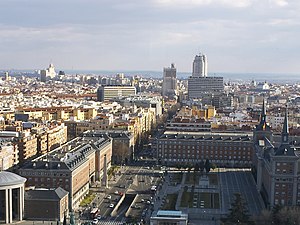 Skyline of Madrid | |
| Motto(s): | |
 Location of Madrid | |
| Country | Spain |
| Region | Community of Madrid |
| Founded | 9th century |
| Government | |
| • Mayor | Alberto Ruiz-Gallardón (PP) |
| Area | |
| • Land | 607 km2 (234 sq mi) |
| • Metro | 10,506 km2 (4,057 sq mi) |
| Elevation | 667 m (2,188 ft) |
| Population (2008) | |
| • City | 3,213,271 |
| • Density | 5,293.69/km2 (13,708/sq mi) |
| • Metro | 7,061,748 |
| population-ranking: 1st | |
| Time zone | UTC+1 (CET) |
| • Summer (DST) | UTC+2 (CEST) |
| Postal code | 28001-28080 |
| Area code | 34 (Spain) + 91 (Madrid) |
| Website | www.munimadrid.es |
Madrid (/məˈdrɪd/; Spanish: [maˈðɾið], colloquially [maˈðɾi]) is the capital and largest city of Spain.[3] It is the third-most populous municipality in the European Union after Greater London and Berlin, and its metropolitan area is the third-most populous city by urban area in the European Union after Paris and London.[4]
The city is located on the river Manzanares in the centre of both the country and the Community of Madrid (which comprises the city of Madrid, its conurbation and extended suburbs and villages); this community is bordered by the autonomous communities of Castile and León and Castile-La Mancha. As the capital city of Spain, seat of government, and residence of the Spanish monarch, Madrid is also the political centre of Spain.[5] The current mayor is Alberto Ruiz-Gallardón from the People's Party. He has been in office since 2003, when he left the Presidency of the Autonomous Community of Madrid and stood as the candidate to replace outgoing mayor José María Álvarez del Manzano, also from the PP. In the last local elections of 2007, Ruiz-Gallardón increased the PP majority in the City Council to 34 seats out of 57, taking 55.5% of the popular vote and winning in all but two districts.
Due to its economic output, standard of living, and market size, Madrid is considered the major financial centre of the Iberian Peninsula; it hosts the head offices of the vast majority of the major Spanish companies, as well as the headquarters of three of the world's 100 largest companies (Telefónica, Repsol-YPF, Banco Santander).[6]
While Madrid possesses a modern infrastructure, it has preserved the look and feel of many of its historic neighbourhoods and streets. Its landmarks include the huge Royal Palace of Madrid; the Teatro Real (Royal theatre) with its restored 1850 Opera House; the Buen Retiro park, founded in 1631; the imposing 19th-century National Library building (founded in 1712) containing some of Spain's historical archives; an archaeological museum; and three superb art museums: Prado Museum, which hosts one of the finest art collections in the world, the Museo Nacional Centro de Arte Reina Sofía, a museum of modern art, and the Thyssen-Bornemisza Museum, housed in the renovated Villahermosa Palace.[7]
The population of the city is roughly 3.2 million (as of December 2005), while the estimated urban area population is 5.1 million. The entire population of the Madrid metropolitan area (urban area and suburbs) is calculated to be 5.84 million. The city spans a total of 698 km² (234 sq mi).[8]
Names of the city



There are several theories regarding the origin of the name "Madrid". According to legend Madrid was founded by Ocno Bianor (son of King Tyrrhenius of Tuscany and Mantua) and was named "Metragirta" or "Mantua Carpetana". Others contend that the original name of the city was "Ursaria" ("land of bears" in Latin), due to the high number of these animals that were found in the adjacent forests, which, together with the strawberry tree ("madroño" in Spanish), have been the emblem of the city from the Middle Ages.[9]
Nevertheless, it is now commonly believed that the origin of the current name of the city comes from the 2nd century B.C. The Roman Empire established a settlement on the banks of the Manzanares river. The name of this first village was "Matrice" (a reference to the river that crossed the settlement). Following the invasions of the Germanic Sueves, Vandals and Alans during the fifth century A.D., the Roman Empire could not defend its territories on the Iberian Peninsula, and were therefore overrun by the Visigoths. The barbarian tribes subsequently took control of "Matrice". In the 7th century the Islamic conquest of the Iberian Peninsula saw the name changed to "Mayrit", from the Arabic term "Mayra" (referencing water as a "trees" or "giver of life") and the Ibero-Roman suffix "it" that means "place". The modern "Madrid" evolved from the Mozarabic "Matrit", which is still in the Madrilenian gentilic.[10]
History
Middle Ages
Although the site of modern-day Madrid has been occupied since pre-historic times,[11] in the Roman era this territory belonged to the diocese of Complutum (present-day Alcalá de Henares). There are archeological remains of a small village during the visigoth epoch, whose name might have been adopted later by Arabs.[9] The origins of the modern city come from the 9th century, when Muhammad I ordered the construction of a small palace in the same place that is today occupied by the Palacio Real. Around this palace a small citadel, al-Mudaina, was built. Near that palace was the Manzanares, which the Muslims called al-Majrīṭ (Arabic: المجريط, "source of water"). From this came the naming of the site as Majerit, which later evolved into the modern-day spelling of Madrid. The citadel was conquered in 1085 by Christian king Alfonso VI of Castile in his advance towards Toledo. He reconsecrated the mosque as the church of the Virgin of Almudena (almudin, the garrison's granary). In 1329, the Cortes Generales first assembled in the city to advise Alfonso XI of Castile. Sephardi Jews and Moors continued to live in the city until they were expelled at the end of the 15th century.[9] After troubles and a large fire, Henry III of Castile (1379–1406) rebuilt the city and established himself safely fortified outside its walls in El Pardo. The grand entry of Ferdinand and Isabella to Madrid heralded the end of strife between Castile and Aragon.[9]
Renaissance

The Kingdom of Castile, with its capital at Toledo, and the Crown of Aragon, with its capital at Zaragoza, were welded into modern Spain by the Catholic Monarchs (Queen Isabella of Castile and King Ferdinand II of Aragon).[9]
Though their grandson Charles I of Spain (also known as Charles V, Holy Roman Emperor) favoured Seville, it was Charles' son, Philip II (1527–1598) who moved the court to Madrid in 1561. Although he made no official declaration, the seat of the court was the de facto capital. Seville continued to control commerce with Spain's colonies, but Madrid controlled Seville.[12]
Aside from a brief period, 1601-1606, when Felipe III installed his court in Valladolid, Madrid's fortunes have closely mirrored those of Spain.

During the Siglo de Oro (Golden Century), in the 16th/17th century, Madrid bore little resemblance to other European capitals, as the population of the city was economically dependent on the business of the court itself, and there was no other significant activity.[12]
From 19th century to present day
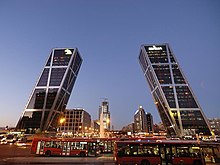
In the late 1800s, Isabel II could not suppress the political tension that would lead to yet another revolt, the First Spanish Republic. This was later followed by the return of the monarchy to Madrid, then the creation of the Second Spanish Republic, preceding the Spanish Civil War.[12]
Madrid was one of the most heavily affected cities of Spain by the Civil War (1936–1939). The city was a stronghold of the Republicans from July 1936. Its western suburbs were the scene of an all-out battle in November 1936 and it was during the Civil War that Madrid became the first city to be bombed by airplanes specifically targeting civilians in the history of warfare. (See Siege of Madrid (1936-39)).[12]
During the dictatorship of Francisco Franco, especially during the 1960s, the south of Madrid became very industrialized, and there were massive migrations from rural areas of Spain into the city. Madrid's south-eastern periphery became an extensive working class settlement, which was the base for an active cultural and political reform.[12]
After the death of Franco, emerging democratic parties (including those of left-wing and republican ideology) accepted King Juan Carlos I as both Franco's successor and as the heir of the historic dynasty - in order to secure stability and democracy. This led Spain to its current position as a constitutional monarchy, with Madrid as capital.[12]
Benefiting from increasing prosperity in the 1980s and 1990s, the capital city of Spain has consolidated its position as an important economic, cultural, industrial, educational, and technological center on the European continent.[12]
Geography
Climate

The region of Madrid has a Continental Mediterranean climate (CSa in the Köppen climate classification, but with some characteristics of Dsa)[13] with cooler winters, due to altitude, including sporadic snowfalls and minimum temperatures usually below 0 °C (32 °F). Summer tends to be hot with temperatures that consistently surpass 30 °C (86 °F) in July and that can rarely reach 40 °C (104 °F). Due to Madrid's altitude and dry climate, nightly temperatures tend to be cooler, leading to a lower average in the summer months. Precipitation levels are low, but precipitation can be observed throughout the year. Summer and winter are the driest seasons, with most rainfall occurring in the autumn and spring.[14]
| Climate data for Madrid | |||||||||||||
|---|---|---|---|---|---|---|---|---|---|---|---|---|---|
| Month | Jan | Feb | Mar | Apr | May | Jun | Jul | Aug | Sep | Oct | Nov | Dec | Year |
| Source: World Meteorological Organization (UN)[15] | |||||||||||||

Water supply
Madrid derives almost 50 percent of its water supply from dams and reservoirs built on the Lozoya River, such as the El Atazar Dam.
Districts
Madrid is administratively divided into 21 districts, which are further subdivided into 128 wards (barrios)
Fuencarral-El Pardo
|
Hortaleza
|
Barajas
| |||
Moncloa
|
Tetuán
|
Chamartín
|
Ciudad Lineal
|
San Blas
|
San Blas |
Chamberi
|
Salamanca
| ||||
Centro
|
Retiro
|
Moratalaz
|
Vicálvaro
| ||
Latina
|
Arganzuela
|
Puente de Vallecas
|
Vallecas
| ||
Carabanchel
|
Usera
| ||||
Villaverde
|
Vallecas | ||||

Metropolitan Area
The Madrid Metropolitan Area (Template:Lang-es) comprises the city of Madrid and forty surrounding municipalities. It has a population of slightly more than 5.8 million people and covers an area of 4.609,7 km². It is the largest metropolitan area in Spain and by one measure the fourth largest in European Union and the 45th largest in the world.
As with many metropolitan areas of similar size, two distinct zones of urbanisation can be distinguished:
- Inner ring (primera corona): Alcorcón, Leganés, Getafe, Móstoles, Fuenlabrada, Coslada, Alcobendas, Pozuelo de Alarcón, San Fernando de Henares
- Outer ring (segunda corona): Villaviciosa de Odón, Parla, Pinto, Valdemoro, Rivas-Vaciamadrid, Torrejón de Ardoz, Alcalá de Henares, San Sebastián de los Reyes, Tres Cantos, Las Rozas de Madrid, Majadahonda, Boadilla del Monte
The largest suburbs are to the South, and in general along the main routes leading out of Madrid.
Submetropolitan areas
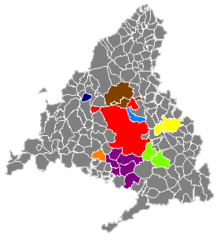
A new project, has stated there are more submetropolitan areas inside Madrid metropolitan area:
(km²) |
(pop.) |
(pop./km²) | |
|---|---|---|---|
| Madrid - Majadahonda | 996.1 | 3,580,828 | 3,595.0 |
| Móstoles | 315.1 | 430,349 | 1,365.6 |
| Fuenlabrada - Leganés - Getafe - Parla - Pinto - Valdemoro | 931.7 | 822,806 | 883.1 |
| Alcobendas | 266.4 | 205,905 | 772.9 |
| Arganda del Rey - Rivas-Vaciamadrid | 343.6 | 115,344 | 335.7 |
| Alcalá de Henares - Torrejón de Ardoz | 514.6 | 360,380 | 700.3 |
| Colmenar Viejo - Tres Cantos | 419.1 | 104,650 | 249.7 |
| Collado Villalba | 823.1 | 222,769 | 270.6 |
| Madrid metropolitan area | 4,609.7 | 5,843,031 | 1,267.6 |
Architecture






Although the site of Madrid has been occupied since prehistoric times, the first historical data that concerns the city dates from the middle of the ninth Century, when Mohammad I ordered the construction of a small palace (site occupied now by the Palacio Real). Around this palace there was built a small citadel (al-Mudaina). The palace was built overlooking the River Manzanares, which the Muslims called Mayrit meaning source of water (which in turn became Magerit, and then eventually Madrid). The citadel was conquered in 1085 by Alfonso VI in his advance towards Toledo. He reconsecrated the mosque as the church of the Virgin of Almudena (almudin, the garrison's granary), now the Catedral de la Almudena. In 1329 the Cortes first assembled in Madrid to advise Fernando IV. Jews and Moors continued to live in the city in their quarter, still known today as the "Moreria", until they were expelled. The Royal Palace of Madrid and the buildings and monuments of the Paseo del Prado (Salón del Prado and Alcalá Gate) deserve special mention. They were constructed in a sober Baroque international style, often mistaken for neoclassical, by the Bourbon kings . Plans for the construction of a new cathedral for Madrid dedicated to the Virgin of Almudena began in the 16th century, but the slow construction did not begin until 1879. Francisco de Cubas, the Marquis of Cubas, was the architect who designed and directed the construction in a Gothic revival style. Construction ceased completely during the Spanish Civil War. The project was abandoned until 1950, when Fernando Chueca Goitia adapted the plans of de Cubas to a neoclassical style exterior to match the grey and white façade of the Palacio Real, which stands directly opposite. and was not completed until 1993, when the cathedral was consecrated by Pope John Paul II.
The financial district in downtown Madrid between the streets Raimundo Fernández Villaverde, Orense, General Perón and Paseo de la Castellana, its original conception (and its name) to the "Plan General de Ordenación Urbana de Madrid", approved in 1946. The purpose of this plan was to create a huge block of modern office buildings with metro and railway connections in the expansion area of northern Madrid, just in front of Real Madrid stadium (currently named the Santiago Bernabéu Stadium) and beside the brand new government complex of Nuevos Ministerios. A botanical garden, a library and an opera house were also included in the plans, but these were never built. Cuatro Torres Business Area is a business park currently under construction. The area will contain the tallest skyscrapers in Madrid and Spain (Torre Espacio, Torre de Cristal, Torre Sacyr Vallehermoso and Torre Caja Madrid).
Madrid Barajas International Airport Terminal 4, designed by Antonio Lamela and Richard Rogers (winning them the 2006 Stirling Prize), and TPS Engineers, (winning them the 2006 IStructE Award for Commercial Structures) was inaugurated on February 5, 2006. Terminal 4 is one of the world's largest terminal areas, with an area of 760,000 square meters (8,180,572 square feet) in two separate terminals. Consisting of a main building, T4 (470,000 square meter), and satellite building, T4S (290,000 square meter), which are separated by approximately 2.5 km. Hong Kong International Airport still holds the title for the world's largest single terminal building (Terminal 1) at 570,000 square meter. The new Terminal 4 is meant to give passengers a stress-free start to their journey. This is managed through careful use of illumination, available by glass panes instead of walls and numerous domes in the roof which allow natural light to pass through. With the new addition, Barajas is designed to handle 70 million passengers annually.
Environment


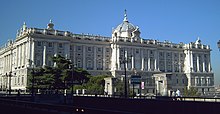
Madrid is full of green spaces and parkland; in central Madrid the largest park is Parque del Retiro, spreading out to the north-east of Atocha Railway station. The station is the core center for high-speed AVE trains, with current lines to Valladolid (North-West), Barcelona (North-East) and Seville (South).
Madrid has many trees, both in parks and on the streets, with about 500,000. In 2005, the city had 300,000 and only Tokyo had more trees (100,000 more), but also had three times more population than Madrid.
Parque del Retiro, formerly the grounds of the palace built for Felipe IV, is Madrid’s most popular park. Its large lake in the middle once staged mini naval sham battles to amuse royalty; these days the more tranquil pastime of pleasure boating is popular. Inspired by London’s crystal palace, the palacio de cristal can be found at the south-eastern end of the park.
In the Retiro Park is also the Forest of the Departed (Spanish Bosque de los Ausentes), a memorial monument to commemorate the 191 victims of the 11 March 2004 Madrid attacks.
Atocha Railway Station is not only the city’s first and most central station but also home to a distinctive indoor garden with 4,000 square meters of tropical plants. Atocha station has become a hothouse destination in itself for plant lovers, with more than 500 species of plant life and ponds with turtle and goldfish in, as well as shops and cafes. It's a nice place to visit on a cold or wet day with its even temperature of 24 degrees Celsius, or even on a scorching summer day as a retreat from the heat.
Casa de Campo is an enormous rural parkland to the west of the city, the largest of all Madrid’s green areas. It’s home to a fairground, zoo and an outdoor municipal pool, to enjoy a bird’s eye view of the park and city take a cable car trip above the tree tops.
The Royal Botanic Garden or Real Jardin Botanico was an 18th century creation by Carlos III, it was used as a base for the plant species being collected across the globe. There is an important research facility that started life as a base to develop herbal remedies and to house the species collected from the new-world trips, today it is dedicated to maintaining Europe’s ecosystem.
The pioneering ecological theme park Faunia, is a natural history museum and zoo combined, aimed at being fun and educational for children. It comprises eight eco-systems from tropical rain forests to polar regions, and contains over 1,500 animals, some of which roam freely
Economy
Economy from Middle Ages to 20th century
During the end of the Middle Ages, Madrid experienced astronomic growth as a consequence of its establishment as the new capital of the Spanish Empire. As Spain (like many other European countries) continued to centralize royal authority, this meant that Madrid took on greater importance as a center of administration for the Spanish Kingdom. It evolved to become an important nucleus of artisanal activity that eventually experienced industrial revolution during of the 19th century. The city made even greater strides at expansion during the 20th century, especially after the Spanish Civil War, reaching levels of industrialization found in other European capital cities. The economy of the city was then centered on diverse manufacturing industries such as those related to motor vehicles, aircraft, chemicals, electronic devices, pharmaceuticals, processed food, printed materials, and leather goods.[16]
Economy from 1992 to 2008
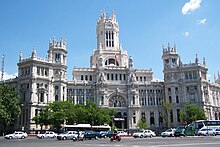

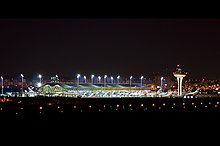

Madrid is a major centre for international business and commerce. It is one of Europe's largest financial centres and the largest in Spain.
During the period from 1992 to 2006, Madrid experienced very significant growth in its service sector. The importance of the Barajas Airport to the city's economy is substantial. The construction of housing and public works, such as the ringroads and train network, constituted a major pillar of the economy up to 2006. As Spain has become decentralized politically, Madrid has taken on a smaller administrative profile as compared to the rest of the Spanish state.
Even so, the Community of Madrid (centered upon the city of Madrid) experienced the highest growth of all the Spanish regions between 2004 to 2006. Its growth rate was higher than for the country as a whole by 1.4% during the period 2000-2006, and that of the Eurozone by 13%.[17]
Madrid has become the 23rd richest city in the world and third richest in Europe in terms of absolute GDP; the economic output for the year 2005 was of $201.5 billion, behind the considerably larger cities of Paris ($460 billion) and London ($452 billion) and ahead of Moscow and Barcelona.[18] Additionally in terms of GDP per capita, Madrid, in specific the Madrid region is the richest in Spain and one of the richest in Europe. At 133.9% of the European average of 25,800€ (34,572€/$48,313) Madrid is ahead of the all other 8 Spanish regions above 100%.[19] Similarly, Madrid is just 97.8% of New York's purchasing power.
Madrid is one of the cities in the Iberian Peninsula that attracts most foreign investment and job seekers. One of the reasons for this are the wages in Madrid; despite medium wage being just 2660€ in Spain, the average salary in Madrid during 2007 was 2540€, clearly above the Spanish average of 2085€.[20] However in terms of net earnings, Madrid places second in Spain; Madrid is 28th in the world, at 78.6%.[21]
One downside of Madrid's quick growth especially over the last 15 years has been the rising cost of living. The city has grown to become the 22nd most expensive city in the world in 2008, the highest any Spanish city has ever featured. Although Madrid is still at 80.7% of New York, dramatic rises since 2005 show that Madrid could easily be challenging the cities higher above the ranks very soon.[22]
Demographics
| Year | Municipality | Community | % |
|---|---|---|---|
| 1897 | 542,739 | 730,807 | 74.27 |
| 1900 | 575,675 | 773,011 | 74.47 |
| 1910 | 614,322 | 831,254 | 73.90 |
| 1920 | 823,711 | 1,048,908 | 78.53 |
| 1930 | 1,041,767 | 1,290,445 | 80.73 |
| 1940 | 1,322,835 | 1,574,134 | 84.04 |
| 1950 | 1,553,338 | 1,823,418 | 85.19 |
| 1960 | 2,177,123 | 2,510,217 | 86.73 |
| 1970 | 3,120,941 | 3,761,348 | 82.97 |
| 1981 | 3,158,818 | 4,686,895 | 67.40 |
| 1991 | 3,010,492 | 4,647,555 | 64.78 |
| 2001 | 2,938,723 | 5,423,384 | 54.19 |
| 2005 | 3,155,359 | 5,964,143 | 52.90 |
| 2006 | 3,128,600 | 6,008,183 | 52.07 |
| 2007 | 3,132,463 | 6,081,689 | 51.51 |
| 2008 | 3,213,271 | 6,271,638 | 51.23 |
| Source: INE | |||
The population of Madrid generally increased from when the city became the national capital in the mid-16th century and stabilised at about 3 million from the 1970s.
From around 1970 until the mid 1990s, the city's population dropped. This phenomenon, which also affected other European cities, was caused in part by the growth of satellite suburbs at the expense of the downtown. Another reason might have been the slowdown in the rate of growth of the European economy.
The demographic boom accelerated in the late 1990s and early 2000s due to international immigration, in response to a strong pick-up in Spanish economic growth. For example, according to census data, the population of the city grew by 271,856 between 2001 and 2005.
As the capital city of Spain, the city has attracted many immigrants from around the world. While more than 83.8% of the inhabitants are Spaniards, there are many recent immigrants who come from Latin America, Europe, Asia, North Africa and West Africa representing 16.2% as of 2007.[23]
The ten largest immigrant groups include: Ecuadorian: 104,184, Romanian: 52,875, Bolivian: 44,044, Colombian: 35,971, Peruvian: 35,083, Chinese: 34,666, Moroccan: 32,498, Dominican: 19,602, Brazilian: 14,583, and Paraguayan: 14,308. There are also important communities of Filipinos, Equatorial Guineans, Bulgarians, Indians, Italians, Argentines, French, Senegalese and Polish.[23]
Government
See also: List of mayors of Madrid

The new democracy heralded a successful movement towards increased autonomy for the regions of Spain, considered as autonomous regions, under the umbrella of Spain.
The City Council consists of 57 councilors, one of them being the Mayor, currently Alberto Ruiz-Gallardón Jiménez. The Mayor presides over the Council. In the 2007 regional an local elections, the conservative Popular Party obtained 34 seats, the Spanish Socialist Workers' Party (PSOE) obtained 18, and United Left obtained 5.
The Plenary of the Council, is the body of political representation of the citizens in the municipal government. Some of its attributions are: fiscal matters, the election and deposition of the Mayor, the approval and modification of decrees and regulations, the approval of budgets, the agreements related to the limits and alteration of the municipal term, the services management, the participation in supramunicipal organizations, etc.[24]
Madrid has tended to be a stronghold of the People's Party, which has controlled the city's mayoralty since 1989.
Culture
Madrid is one of Spain's most popular destinations and is renowned for its large quantity of cultural attractions.
Galleries
Madrid is considered one of the top European destinations concerning art museums. Best known is the Golden Triangle of Art, located along the Paseo del Prado and comprising three museums. The most famous one is the Prado Museum, the most popular Golden Triangle of Art member known for such highlights as Diego Velázquez's Las Meninas and Francisco de Goya's La maja vestida and La maja desnuda. The other two museums are the Thyssen Bornemisza Museum, established from a mixed private collection, and the Reina Sofia Museum. This is where Pablo Picasso's Guernica hangs, returning to Spain from New York after more than two decades.


Museums
- Museo del Prado (El Prado Museum)
- National Archaeological Museum of Spain
- Museo Nacional Centro de Arte Reina Sofía
- Museo Thyssen-Bornemisza
- Museum of the Americas
- Royal Academy of Fine Arts of San Fernando
- Naval Museum
- Casa-Museo José Padilla *
- Casa-Museo Manuel Benedito *
- Museo de Antropologia Médica *
- Museo De La Farmacia Hispana *
- Museo Del Reloj Grassy *
- Museo Lazaro Galdiano *
Nightlife

Madrid is notable for its nightlife and night clubs. On weekends, Madrilenian youth are known for dancing all night long, stopping only to go home, take a shower, shave (or not), and go to work.

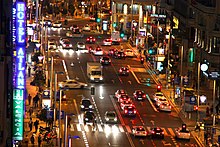
What is also popular is the practice of meeting in parks or streets with friends and drinking alcohol together (this is called 'botellón', from 'botella', bottle), but in recent years, drinking in the street is punished with a fine and now young madrileños drink together all around the city instead of in better-known places. Many places host bands (concerts in Madrid[25]). Nightlife and young cultural awakening flourished after the death of Franco, especially during the 80s while Madrid's mayor Enrique Tierno Galván (PSOE) was in office, at this time is well-known the cultural movement called la movida and it initially gathered around Plaza del Dos de Mayo. Nowadays, the Malasaña area is known for its alternative scene. Some of the most popular night destinations include the neighbourhoods of: Bilbao, Tribunal, Alonso Martinez or Moncloa, together with Puerta del Sol area (including Opera and Gran Via, both adjacent to the popular square) and Huertas (barrio de Las Letras), destinations which are also filled with tourists day and night. The district of Chueca has also become a hot spot in the Madrilenian night life.
Classical music and opera
The Auditorio Nacional de Música [26] is the main venue for classical music concerts in Madrid, is home to the Spanish National Orchestra, the Chamartín Symphony Orchestra [27] and the venue for the symphonic concerts of the Community of Madrid Orchestra and the Madrid Symphony Orchestra. It is also the principal venue for orchestras on tour playing in Madrid. The Teatro Monumental’s resident orchestra is the RTVE Symphony Orchestra.[28]
The Teatro Real is the main opera house in Madrid and its resident orchestra is the Madrid Symphony Orchestra.[29] The Teatro de la Zarzuela is mainly devoted to Zarzuela (the Spanish traditional musical theatre genre), as well as operetta and recitals.[30][31] The resident orchestra of the theatre is the Community of Madrid Orchestra.
Other concert venues for classical music are the Fundación Joan March and the Auditorio 400, devoted to contemporary music.
Bullfighting
Madrid hosts the largest Plaza de Toros (bullring) in Spain, Las Ventas, established in 1929. Las Ventas is considered by many to be the world center of bullfighting and has a seating capacity of almost 25,000. Madrid's bullfighting season begins in March and ends in October. Bullfights are held every day during the festivities of San Isidro (Madrid's patron saint) from the middle of March to the middle of June, and every Sunday, and public holiday, the rest of the season. The style of the plaza is Neomudéjar. Las Ventas also hosts music concerts and other events outside of the bullfighting season.
Local festivities
- May 15, San Isidro Labrador (Madrid's patron saint).
- June 13, San Antonio de la Florida.
- July 16-25, Virgen del Carmen festivities (Patron saint of the sea).
- August 6-14, Virgen de la Paloma festivities (Madrid's patron saint)
- August 7, San Cayetano (Cascorro neighbourhood's patron saint).
- August 10, San Lorenzo (Lavapiés neighbourhood's patron saint).
- November 9, Virgen de la Almudena festivities (Madrid's patron saint).
Sport

Madrid is home to Real Madrid, who play in the Estadio Santiago Bernabéu. Their supporters are referred to as vikingos, Vikings, or, more commonly, merengues, meringues. Real Madrid is one of the most prestigious football clubs in the world, having won 9 European Cups. Their hometown rivals, Atlético Madrid, are also well supported in the city, and their supporters are called los sufridores, the sufferers. The players are referred to as colchoneros, mattresses, in reference to the teams red & white jerseys having been determined by mattress material being the cheapest at the time of the club's formation. Madrid's contribution to the sport is further noticed by the fact that it hosted the 1982 FIFA World Cup final. Along with Barcelona, Glasgow and Lisbon Madrid is one of four cities in Europe to contain two UEFA 5-star stadia: Real Madrid's Santiago Bernabéu and Atlético Madrid's Vicente Calderón both meet the criteria.
Some of Spain's top footballers are Madrileños, including Real Madrid legend Emilio Butragueño and co (La Quinta del Buitre, "The Vulture's Cohort"), Liverpool's Pepe Reina and Fernando Torres and Real Madrid veterans Raúl González and Iker Casillas.
The city is also host to two basketball teams in the Asociación de Clubs de Baloncesto (ACB league), and the Circuito Permanente Del Jarama, a motorsport race circuit which formerly hosted the Formula One Spanish Grand Prix. Historically, the city serves as the last stage of the Vuelta a España cyclist classic in the same way as Paris does in the Tour de France.
Skiing is possible in the nearby mountains of the Sierra de Guadarrama, where the ski resorts of Valdesqui and Navacerrada are located.
The city bid for hosting the 1972 and 2012 Summer Olympics, which were lost to Munich and London respectively. Nevertheless, Madrid is currently bidding to host the 2016 Summer Olympics.
Education
State Education in Spain is free, and compulsory from 6 to 16 years. The current education system is called LOGSE (Ley de Ordenación General del Sistema Educativo).[32]
Universities
Madrid is home to a large number of public and private universities. The Autonomous University of Madrid is the number one ranked public university in Spain[by whom?], and was instituted under the leadership of the physicist, Nicolás Cabrera. Known simply as la Autónoma in Madrid, its main site is the Cantoblanco Campus, situated 10 miles (16 km) to the northeast of the capital (M-607) and close to the municipal areas of Madrid, namely Alcobendas, San Sebastián de los Reyes, Tres Cantos and Colmenar Viejo.

Another university is the Complutense University of Madrid founded in 1293, which is one of the oldest universities in the world. It has 10,000 staff members and a student population of 117,000. It is located on two campuses, in the university quarter Ciudad Universitaria at Moncloa in Madrid, and in Somosaguas.[33]
Other universities in Madrid: Universidad Carlos III de Madrid (public), Technical University of Madrid (public), Universidad Pontificia Comillas (private), Rey Juan Carlos University (public), Universidad Alfonso X, Universidad Antonio de Nebrija, Universidad Camilo José Cela, Universidad Francisco de Vitoria, Universidad Europea de Madrid, Universidad Pontificia de Salamanca Campus de Madrid, Saint Louis University Madrid Campus and Universidad San Pablo CEU (all of them private).
Madrid is also home to the Escuela Superior de Música Reina Sofía, the Real Conservatorio Superior de Música de Madrid and many other private educational institutions.
Business Schools
IE Business School (formerly Instituto de Empresa) has its main campus on the border of the Chamartín and Salamanca districts of Madrid. Although based in Barcelona, both IESE Business School and ESADE Business School also have Madrid campuses. These three schools are the top-ranked business schools in Spain, consistently rank among the top 20 business schools globally, and offer MBA programs (in English or Spanish) as well as other business degrees. Other Madrid universities that have MBA programs include:
- Universiad Carlos III de Madrid through the Centro de Ampliación Estudios (in English or Spanish).
- Universidad Pontificia Comillas de Madrid (in Spanish only).
- Universidad Politécnica de Madrid (in Spanish only).
Transport
Air
Madrid is served by Barajas International Airport. Barajas is the main hub of Iberia Airlines. It consequently serves as the main gateway to the Iberian peninsula from Europe, America and the rest of the world. Current passenger volumes range upwards of 52 million passengers per year, putting it in the top 10 busiest airports in the world.[34] Given annual increases close to 10%, a new fourth terminal has been constructed. It has significantly reduced delays and doubled the capacity of the airport to more than 70 million passengers per year. Two additional runways have also been constructed, making Barajas a fully operational four-runway airport.
The Councillor of Transports of the Community of Madrid, Manuel Lamela, announced in 2007 that the city will also be served by two new airports which are expected to be fully operative in 2016, first of them will be located in Campo Real, it will be initially be used for cargo flights, but also as hub for low-cost carriers, and the second one, expected to be built between the two municipalities of El Álamo and Navalcarnero, which will only take over the routes operating in Cuatro Vientos Airport
National Rail


Spain's railway system, the Red Nacional de Ferrocarriles Españoles (Renfe) operates the vast majority of Spain's railways. In Madrid, the main rail terminals are Atocha in the south and Chamartín in the north.
The most important project in the next decade is the Spanish high speed rail network, Alta Velocidad Española AVE. Currently, an ambitious plan includes the construction of a 7,000 kilometre (4,350 mi) network, centered on Madrid. The overall goal is to have all important provincial cities be no more than 4 hours away from Madrid, and no more than 6 hours away from Barcelona. As of 2008, AVE high-speed trains link Atocha station to Seville, Málaga and Toledo in the south and to Zaragoza, Lleida, Tarragona and Barcelona in the east. AVE trains also arrive from Valladolid and Segovia.
RENFE offers:

Metro
Serving a population of some four million, the Madrid Metro is one of the most extensive and fastest-growing metro networks in the world.[35] With the addition of a loop serving suburbs to Madrid's south-west "Metrosur", it is now the second largest metro system in Western Europe, second only to London's Underground. In 2007 Madrid's metro system was expanded and it currently runs over 283 kilometers (176 miles) of line. The province of Madrid is also served by an extensive commuter rail network of 370 kilometers (230 miles) called Cercanías.
International relations
Twin towns - Sister cities
Partner cities
Notes
- ^ "Los fuegos que conmocionaron Madrid". 20minutos.es (in Spanish). 2006-09-06. Retrieved 2008-08-13. Template:Es icon
- ^ D. Ramón de Mesonero Romanos (1881). Oficinas de la Ilustración Española y Americana (ed.). "El antiguo Madrid : paseos históricos-anedócticos por las calles y casas de esta villa". Retrieved 2008-08-13. Template:Es icon
- ^ http://www.ine.es/ Instituto Nacional de Estadística (National Statistics Institute)
- ^ "World Urban Areas: Population & Density" (PDF). Demographia. Retrieved 2008-08-10.
- ^ "Madrid". Indiana.edu. July 10, 2006.
- ^ DeCarlo, Scott (2006-03-30). "The World's 2000 Largest Public Companies". Forbes. Retrieved 2007-01-16.
- ^ "Madrid: ". Easy expat. August 11, 2006.
- ^ "Indicadores Socioeconómicos: Comunidad de Madrid". Ministerio de Administraciones Públicas. August 11, 2006.
- ^ a b c d e "El Madrid Medieval (Medieval Madrid). Includes Pre-historic, roman and medieval up to the Catholic Monarchs times". History of Madrid. (in Spanish). José Manuel Castellanos. Retrieved 2007-10-28.
- ^ "El origen del nombre". JLL & JRP. August 16, 2006.
- ^ http://elmadridmedieval.jmcastellanos.com/ Pre-historic times in Madrid (Spanish Only)
- ^ a b c d e f g "Madrid, de territorio fronterizo a región metropolitana. Madrid, from being the "frontier" to become a Metropole". History of Madrid. (in Spanish). Luis Enrique Otero Carvajal (Profesor Titular de Historia Contemporánea. Universidad Complutense. Madrid). Retrieved 2007-10-28.
- ^ "Climate in Madrid". Webserver.dmt.upm.es. Retrieved 2009-07-08.
- ^ Wunderground Forecast for Spain
- ^ "Weather Information for Madrid".
{{cite web}}: Unknown parameter|dateformat=ignored (help) - ^ "Overview: Economy of Madrid". EasyExpat. August 16, 2006.
- ^ "Madrid Economy" (PDF). Empresa Municipal Promoción de Madrid. Retrieved 2008-08-15.
- ^ "City Mayors reviews the richest cities in the world in 2005". Citymayors.com. 2007-03-11. Retrieved 2009-07-08.
- ^ Colpisa. "Ocho regiones españolas superan ya el PIB medio de la Unión Europea. La Verdad". Laverdad.es. Retrieved 2009-07-08.
- ^ "El salario medio bruto se acerca a 2.000 euros en el segundo trimestre del año". elmundo.es. 2007-09-20. Retrieved 2009-07-08.
- ^ "World's richest cities in 2008". City Mayors. Retrieved 2009-07-08.
- ^ "World's most expensive cities in 2008 - Ranking". City Mayors. Retrieved 2009-07-08.
- ^ a b Foreign Population in the city of madrid. A study by the Dirección General de Estadística of the municipality of Madrid
- ^ Pleno de Madrid (Spanish Only)
- ^ Mondosonoro - Bandas en Madrid
- ^ "Auditorio Nacional de Música". Time Out. Retrieved 2009-08-19.
- ^ "Orquesta Sinfónica Chamartín-Historia (in Spanish)". Orquesta Sinfónica Chamartín. 20 February 2008. Retrieved 2008-08-28.
- ^ "La Orquesta Sinfónica (in Spanish)". RTVE. Retrieved 24 August 2009.
- ^ "Teatro Real (Timeout Madrid)". Retrieved 2009-01-31.
- ^ History of the Teatro de la Zarzuela
- ^ Teatro de la Zarzuela - Timeout Madrid
- ^ Sistema Educativo LOE by the Spanish Ministry of Education(Spanish Only)
- ^ "Universidad Complutense". Missouri-St. Louis University. July 10, 2006.
- ^ Preliminary Air Traffic Results for 2006 from Airports Council International
- ^ "Madrid Metro". Robert Schwandl. August 17, 2006.
- ^ a b c d e f g h i j k l m n o p q r s t u v w x y z aa ab ac Madrid city council webpage "Mapa Mundi de las ciudades hermanadas". Ayuntamiento de Madrid.
{{cite web}}: Check|url=value (help) - ^ "Sister Cities". Beijing Municipal Government. Retrieved 2008-09-23.
- ^ "Berlin's international city relations". Berlin Mayor's Office. Retrieved 2009-07-01.
- ^ "Sister Cities of Manila". © 2008-2009 City Government of Manila. Retrieved 2009-07-02.
{{cite web}}: External link in|publisher= - ^ "NYC's Sister Cities". Sister City Program of the City of New York. 2006. Retrieved 2008-09-01.
- ^ "Twinning Cities: International Relations" (PDF). Municipality of Tirana. www.tirana.gov.al. Retrieved 2009-06-23.
- ^ "International Relations: Special Partners". Mairie De Paris.
40°24′N 3°41′W / 40.400°N 3.683°W
See also
- 11 March 2004 Madrid train bombings
- Forest of the Departed
- List of mayors of Madrid
- Large Cities Climate Leadership Group
- Madrid Conference of 1991
External links
- Template:Wikitravel
- The Official Website for Madrid on Tourism and Business
- WikiSatellite view of Madrid at WikiMapia
- Photos of Madrid
- Template:Fr Madrid : à la découverte des plus beaux musées de la capitale de l'Espagne
- History of Madrid
- Development and History of the city of Madrid
- Template:PDFlink, 1996, retrieved January 7, 2006
- " En algunos barrios de Madrid el 40% de la poblacion ya son inmigrantes " retrieved on January 7, 2006
- A guide to the natural history of Madrid




